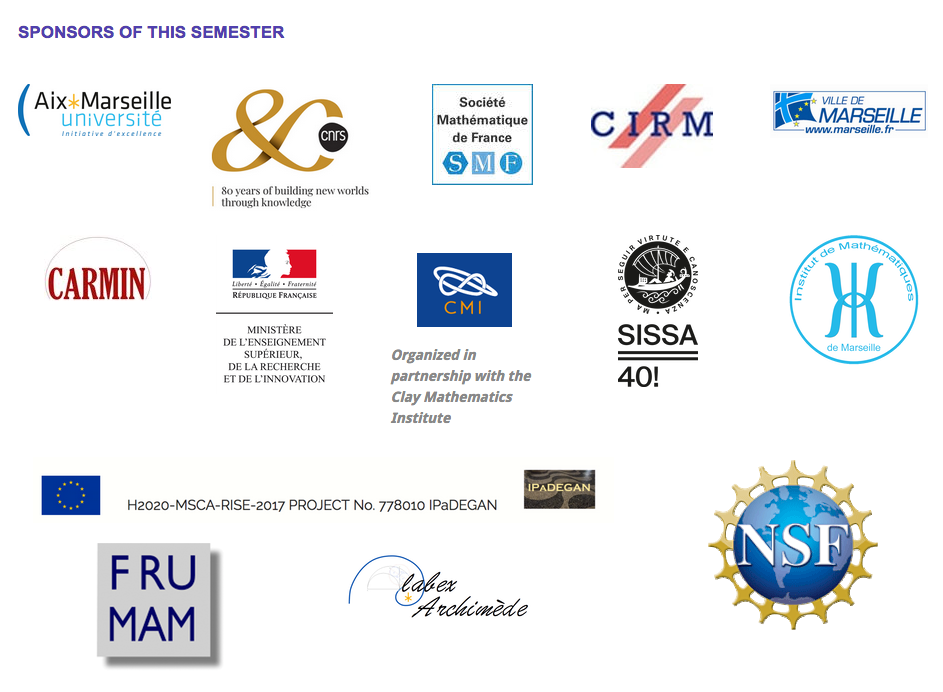Integrability and Randomness in Mathematical Physics and Geometry
L’intégrabilité et l’aléatoire en physique mathématique et en géométrie
Dates: 8 -12 April 2019
Place: CIRM (Marseille Luminy, France)
|
DESCRIPTION
Over the last 20 years integrability has assumed an increasingly prominent role in various fields of mathematical physics. The modern theory of integrable systems grew up around the study of the Korteweg de Vries (KdV) equation, with origins in the seminal work of Zabusky and Kruskal about the recurrence behaviour of solutions, the discovery of the Lax pair, multi-soliton solutions and infinite number of conservation laws.
In other surprising connections, integrable systems like the KdV equation and the Toda lattice were proven to appear in fundamental combinatorial models, in random matrices and the geometry of moduli spaces. Here is a short list of relevant examples: 1. The generating function of Hurwitz numbers and various classes on moduli spaces coincide with tau-functions of integrable systems. 2. Partition functions of exactly solvable statistical models like the Ising model and the six vertex model have been shown to be tau-functions of integrable equations. 3. Random particle models appearing through connections to representation theory have an integrable structure, now referred to as integrable probability. 4. Local statistics of a large collection of exactly solvable matrix models in scaling limits (either in the bulk or at spectral edges) are related to integrable operators and determinantal point processes). This relationship has recently been proven, via perturbative results, to be universal and valid for more general classes of non-integrable models like the Wigner matrices. In general, integrability provides the route to an explicit description of the answer. This statement is quite true also in the theory of nonlinear PDEs where the typical behaviour of integrable PDEs is canonical far beyond the integrable examples. Finally, the phenomenon of recurrence in solutions, as opposed to thermalisation, first observed in the FPU model and then in the Zabusky and Kruskal experiment for KdV, leads to the field of meta-stability and opens the question of typical behaviour of solutions of PDEs in the periodic setting over long times. Information about both typical behaviour and fluctuations when initial data is sampled from a suitable probability measure are generally more relevant for understanding the behaviour of real systems than the solution of a specific initial value problem. The aim of the conference is to foster interactions among researchers that work in the following fields:
Au cours des 20 dernières années, l’intégrabilité a pris une place de plus en plus importante dans divers domaines de la physique mathématique. La théorie moderne des systèmes intégrables s’est développée autour de l’étude de l’équation de Korteweg de Vries (KdV), dont les origines remontent aux travaux fondateurs de Zabusky et Kruskal sur le comportement de récurrence des solutions, la découverte de la paire de Lax, les solutions multi-soliton et un nombre infini de lois de conservation.
Dans d’autres connexions surprenantes, des systèmes intégrables comme l’équation KdV et le réseau de Toda ont fait leurs preuves dans des modèles combinatoires fondamentaux, dans des matrices aléatoires et dans la géométrie d’espaces modulables. En général, l’intégrabilité fournit la voie vers une description explicite de la réponse. Cette affirmation est tout à fait vraie aussi dans la théorie des EDP non linéaires où le comportement typique des EDP intégrables est canonique bien au-delà des exemples intégrables. Enfin, le phénomène de récurrence des solutions, par opposition à la thermalisation, d’abord observé dans le modèle FPU puis dans l’expérience de Zabusky et Kruskal pour KdV, conduit au champ de la méta-stabilité et ouvre la question du comportement typique des solutions des EDPs dans le cadre périodique sur de longues périodes. Les informations sur le comportement typique et les fluctuations lorsque les données initiales sont échantillonnées à partir d’une mesure de probabilité appropriée sont généralement plus pertinentes pour comprendre le comportement des systèmes réels que la solution d’un problème de valeur initiale spécifique. Le but de cette conférence est de favoriser les interactions entre les chercheurs travaillant dans les domaines suivants :
|
SCIENTIFIC COMMITTEE
ORGANIZING COMMITTEE
SPEAKERS
POSTER SESSION
ALL POSTER SLIDES (click to see)
|




